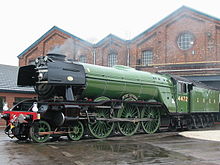London and North Eastern Railway

The London and North Eastern Railway ( LNER ) was the second largest of the so-called "Big Four", the four British railway companies that were created in 1923 as part of a reorganization of the railway system on the basis of the Railways Act 1921 , known as grouping . The company existed from January 1, 1923 until the creation of British Railways on January 1, 1948 .
founding
When the Railways Act 1921 came into force on January 1, 1923, LNER was created by amalgamating numerous railway companies. The route network had a total length of 6,590 miles (10,606 km). Most of this, 1,757 miles (2,828 km), was from the North Eastern Railway, followed by the North British Railway at 1,378 miles (2,218 km).
The LNER was involved with the London, Midland and Scottish Railway (LMS) in the Midland and Great Northern Joint Railway , which was then completely absorbed by the LNER in 1936.
Route network
As the name suggests, the LNER served the eastern and northern parts of the country from London up to Scotland . Most of England east of the Pennines belonged to the LNER territory, including the plains of East Anglia . The King's Cross station was the main London railway station of the LNER. This is where the central East Coast Main Line begins via York and Newcastle upon Tyne to Edinburgh . Other important routes run from Edinburgh to Aberdeen and Perth . The company's main workshops were in Doncaster .
Vehicle fleet and infrastructure
Typical for the LNER were the express train locomotives with light green paintwork (applegreen, also called Doncaster green) and the teak-colored passenger coaches.
After the merger, LNER owned
- 7,700 steam locomotives, 140 electric railcars, 6 electric locomotives and 10 railcars with combustion engines
- 20,000 passenger coaches and 29,700 freight wagons
- 12 ocean-going vessels and a large number of inland vessels
- Docks, docks and piers in more than 20 different locations including Harwich and London
- 23 hotels
Senior Engineers
Sir Nigel Gresley , one of the world's most famous locomotive designers, was Chief Mechanical Engineer (CME) for LNER between 1923 and 1941 , a position he had previously held with the Great Northern Railway. His creations include the officially fastest steam locomotive in the world, the “Mallard” ( class A4 ) and the no less famous class A3 , to which the “Flying Scotsman” locomotive shown in the picture above belongs.
Edward Thompson followed in 1941 , who was in office until 1946. Arthur Peppercorn only worked for 18 months, among other things he designed the LNER class A1 Peppercorn .
nationalization
The LNER was nationalized in 1948 and merged with the other three of the "Big Four" into British Railways . One reason for this merger was to simplify and accelerate the repair of war damage organizationally. After the privatization of British Rail, the franchise for the long-distance express trains on the East Coast Main Line went to the Great North Eastern Railway (GNER), whose name was deliberately chosen to be reminiscent of the LNER.
Origin companies of LNER
Main companies
The main companies that made up the LNER were (length of the route network in brackets):
- Great Eastern Railway (GER) 1917 km
- Great Central Railway (GCR) 1,372 km
- Great Northern Railway (GNR) 1,692 km
- Great North of Scotland Railway (GNSR) 538 km
- Hull and Barnsley Railway (H&BR) 171 km, merged with the NER on April 1, 1922
- North British Railway (NBR) 2218 km
- North Eastern Railway (NER) 2829 km
Societies
Three other companies operated independently:
- Colne Valley and Halstead Railway (31 km)
- East and West Yorkshire Union Railway (15 km)
- Mid-Suffolk Light Railway (31 km)
Subsidiaries
The subsidiaries existed only in name, but were nevertheless mentioned in the Railways Act for legal reasons.
Original parent company NER:
- Brackenhill Light Railway
- Forcett Railway (9 km)
- Great North of England, Clarence and Hartlepool Junction Railway (10 km)
Original parent company GCR:
- Humber Commercial Railway and Dock
- Mansfield Railway (16 km)
- North Lindsey Light Railway (19 km)
- Seaforth and Sefton Junction Railway
- Sheffield District Railway (7 km)
Original parent company GER:
- London and Blackwall Railway (10 km)
Original parent company GNR:
- East Lincolnshire Railway (76 km)
- Horncastle Railway (12 km)
- Nottingham and Grantham Railway and Canal (37 km)
- Nottingham Suburban Railway (6 km)
- Stamford and Essendine Railway (20 km)
Original parent company NBR:
- Edinburgh and Bathgate Railway (16 km)
- Forth and Clyde Junction Railway (49 km)
- Gifford and Garvald Railway (15 km)
- Kilsyth and Bonnybridge Railway (14 km)
- Lauder Light Railway (16 km)
- Newburgh and North Fife Railway (21 km)
Original parent company H&BR:
- South Yorkshire Junction Railway (18 km)
Two or more original parent companies:
Independently operated joint ventures
- East London Railway : Jointly leased by LNER, Southern Railway , Metropolitan Railway (MetR) and Metropolitan District Railway . Passenger traffic through MetR, goods traffic through LNER
- Cheshire Lines Committee : LNER and London, Midland and Scottish Railway (LMSR) operate jointly . LNER provided locomotives, CLC provided the rest of the rolling stock.
- Manchester, South Junction and Altrincham Railway : Joint operation by LNER and LMSR
Web links
- LNER Encyclopedia (English)
